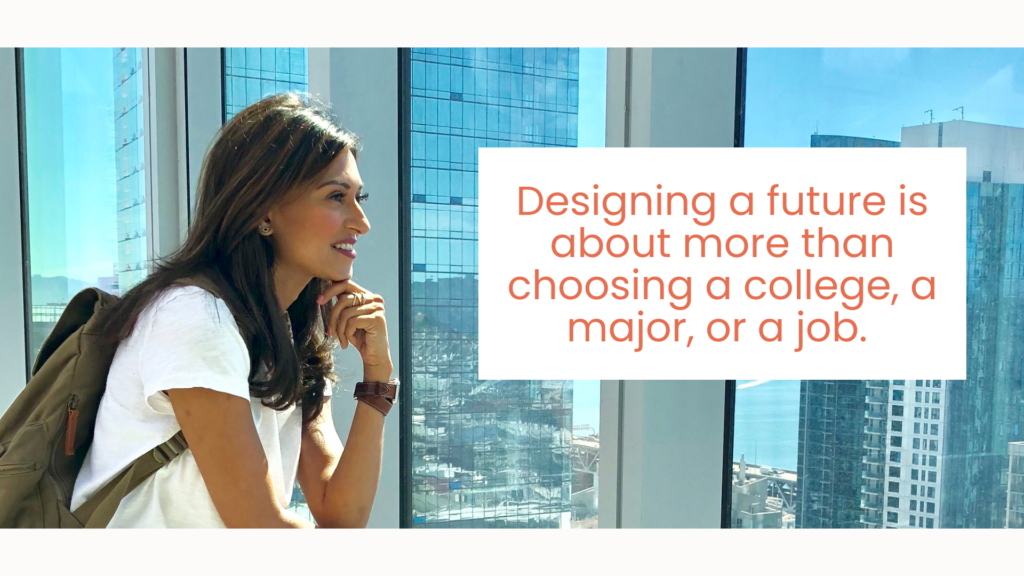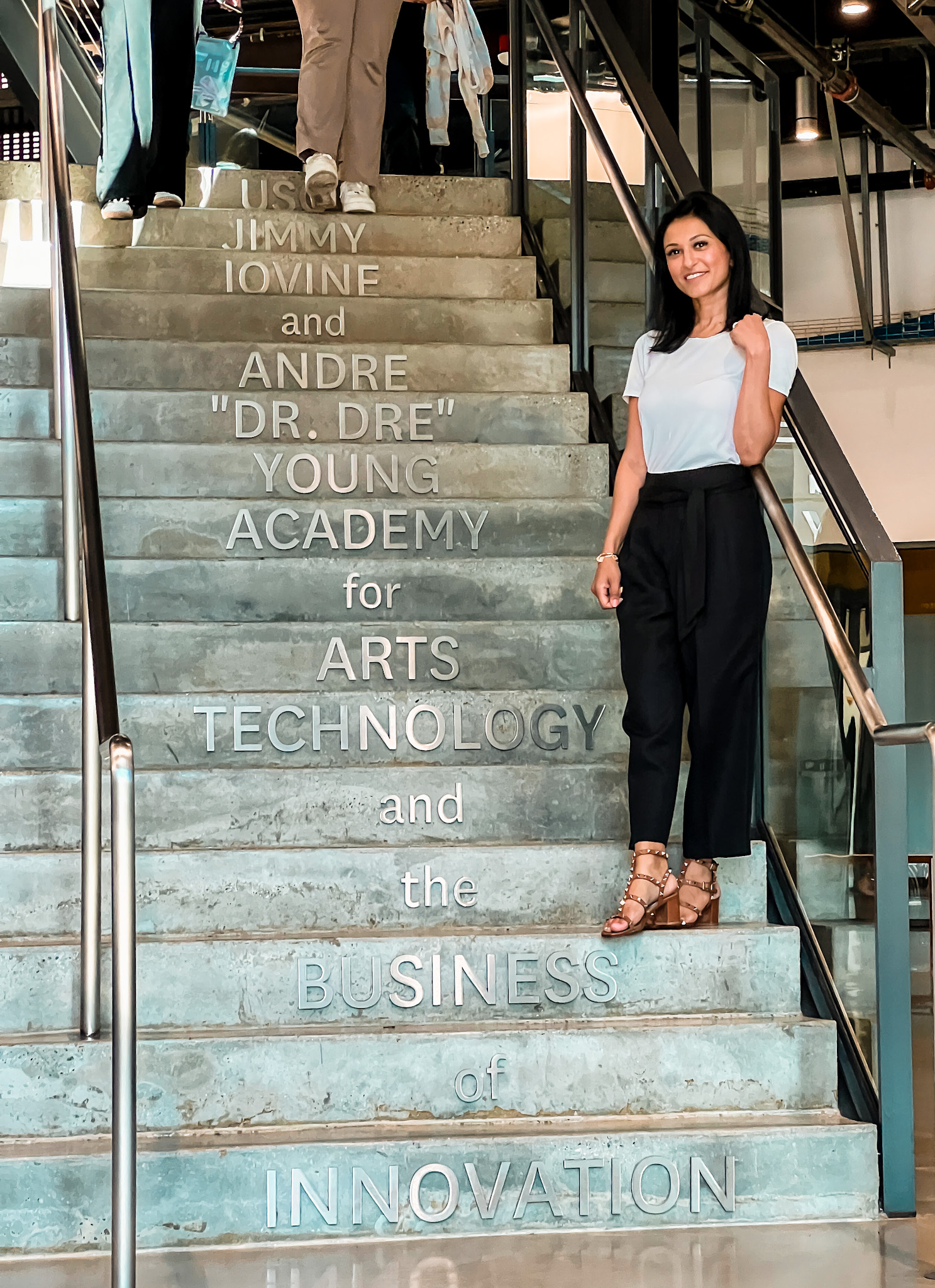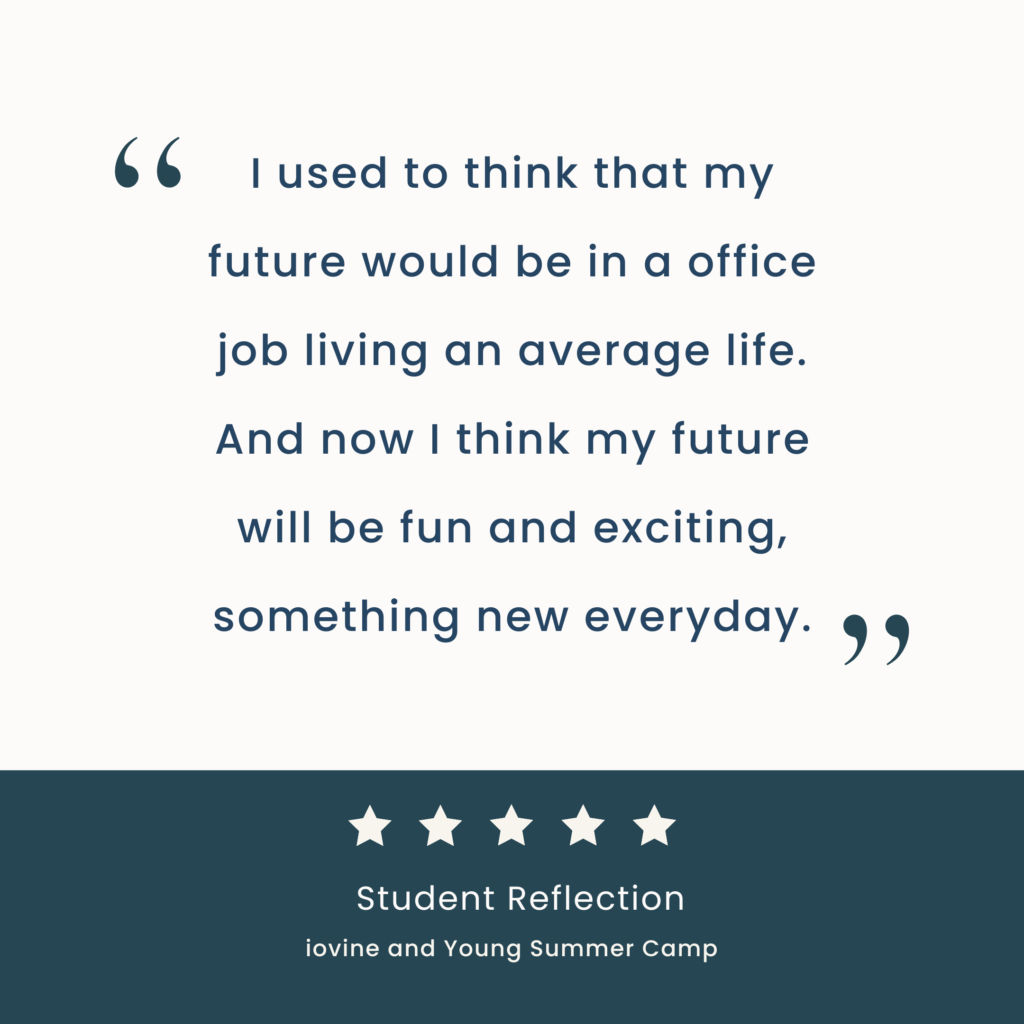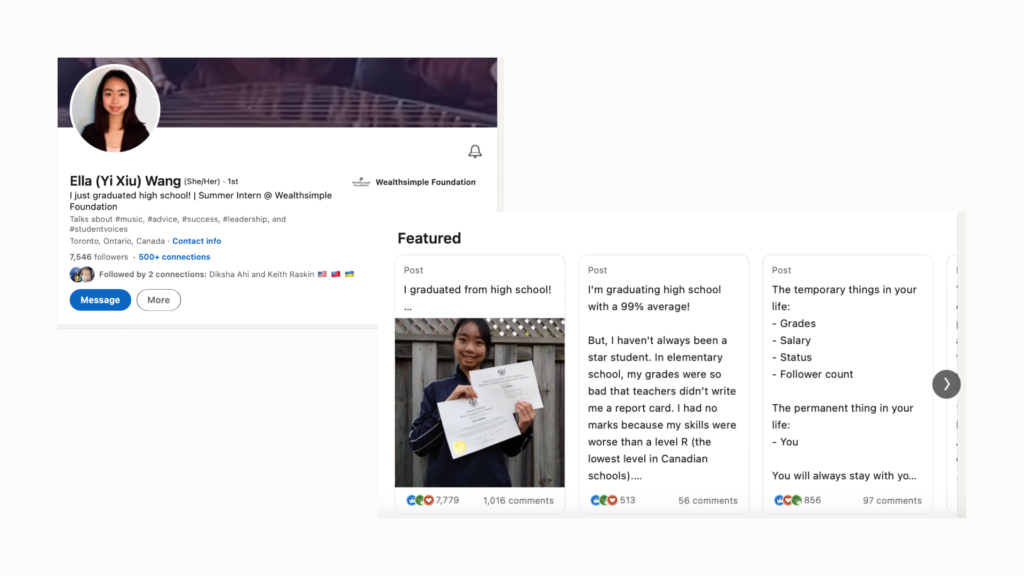Imagine if every student introduced themselves by saying:
- Hi! I’m ____ and I’m working on _____.
Instead of:
- Hi I’m a freshman and I go to ____insert school name_____.
Do you notice the difference?
In the first one, the introduction is personalized. Why? Because the experience is personalized.
In the second example the introduction is generic. Why? Because the experience often is.

Last month I was invited by Matthew Manos, assistant professor at the Iovine and Young Academy at the University of Southern California, to deliver a closing keynote for their high school summer camp.
The students in the camp had been learning about design thinking, entrepreneurship, and more.
As I thought about the experience I wanted to create for this group I knew I wanted it to share career navigation strategies for how they could take what they had learned, and carry it forward.
Especially because they were returning to a more traditional high school experience.



Schools as Startups. Students as Founders
When I reflect back on my own school experience, I often introduced myself with my name, major, and university. In 2018 I went back to graduate school to do my doctorate. This time when I was asked I said, “I’m Sabba. I’m a student currently working on my dissertation that I’m going to turn into a documentary. It’s about how design thinking can be used to challenge the traditional structures that exist in our current education model.”
I didn’t mention the school name.
I didn’t mention my degree name.
In my answer, I talked about my purpose, my vision, my goals, and my dreams.
In my 30’s was when I had the opportunity to apply the career navigation strategies I should have had a decade earlier. As they say, it’s never too late. So when I returned to school in 2018 I applied the number one career development strategy I learned.
I treated school like it was my startup.
A place to experiment with ideas. A place where my first try would not be my last try. A low stakes environment where I could experiment with creating a podcast, documenting my experience on my blog, and creating a documentary. All of which I did.
School is the ultimate place to test ideas, to take risks, to try and try again as you learn new skills and nurture a growth mindset. Through this experience I also learned that one of the most powerful titles you hold is, “I’m a student.”
ARVE Error: src mismatchprovider: youtube
url: https://www.youtube.com/watch?v=kHOZf3KuACo&t=5s
src in org: https://www.youtube-nocookie.com/embed/kHOZf3KuACo?start=5&feature=oembed
src in mod: https://www.youtube-nocookie.com/embed/kHOZf3KuACo?start=5
src gen org: https://www.youtube-nocookie.com/embed/kHOZf3KuACo
How did I learn this?
At the same time I was also an “Education Leadership Executive” at Apple. Pretty fancy title and one that you think would get a lot of attention. It didn’t. People usually thought I wanted to sell them something, so before a conversation even began there was an assumption.
When I said I was a student, people leaned in ready to support, mentor, coach, come on the podcast for an interview, or be featured in the documentary. I never imagined that people whose books I was reading, people whose ideas had influenced the trajectory of my career and my own personal development could be so accessible by simply writing an email or a tweet. People like Seth Godin and Erik Brynjolfsson. That’s the power of the technology that we have in our hands.
Design Your Future: How to Figure Out What’s Next
Being a student is one of the most powerful titles you’ll hold, and school is one of the best places to discover who you are, what you enjoy, what your strengths are, and to build relationships with people you want to learn and grow with. School should be the place where you design your future and figure out what’s next.
Returning to school was such a powerful experience that I want every student to experience it. It’s why I created a self-paced course for students that any teacher, any counselor, any parent, any school can integrate into the day for students. When you think back to what made you successful in your career, it’s often the things that you had to figure out on your own AFTER GRADUATION, when really it should have happened before.
When I shared the 3 strategies outlined below, here are some student reflections from my classic workshop closing question, “When thinking about designing your future I used to think…. and now I think…”



3 Strategies to Design Your Future
In the keynote I shared three strategies students can begin using today. Strategies that they could use to build upon the design thinking practices they had learned during their summer camp, to take back as they returned to their high schools.
Strategy 1: Self-Awareness
Jobs are eliminated. Industries evolve.
Self-awareness is the foundation of being able to adapt to the world around you. We often talk about how AI will replace jobs, and while that is true, jobs can be replaced but industries evolve. When you begin with a strong understanding of your strengths, skills, and interests you recognize where they can be applied. The best place to start is by asking, “What energizes you?”
To do this I recommend taking the Sparketype assessment. It’s free and shares both what energizes you at work, and what drains you. Understanding what energizes you opens up opportunities for you to be a part of that you may have otherwise never considered.
Note: We also share how these resorts have great language to adapt to use in a cover letter, or when filling out an application. After all it’s a description of who you are and what you love doing. To keep the discovery going beyond the Sparketype I shared a 30-day journal challenge with students.
Strategy 2: Goal Setting
Every day we make a decision. We either move one step closer or one step further from our goals.
Students often share vague, and often aspirational goals. The other day at dinner my friend’s daughter said, “I want to go to Harvard and be a lawyer.”
Her dad elaborated and said, “She loves Law and Order, and I’m so excited she wants to be a lawyer.”
Great goal. Zero strategy. And as we all learned after graduation, jobs on TV aren’t anything close to what they are like in real life.
While no goal should ever be discouraged, providing young people with the strategies, skills, and resources to define and reach their goals is essential. Consider the difference between these two goals.
I want to go to Harvard and be a lawyer.
I want to go to Harvard and be a lawyer. So over the next 2 months, I’m going to connect with 2 current students, and 2 alumni using LinkedIn to learn more about their experience and how they see the industry evolving. I’m a freshman and I imagine the world will evolve tremendously so I’m curious to hear what trends they are noticing and what advice they have for what I should focus on, and the skills I should develop. After collecting these insights, I’ll determine next steps.
That’s the difference between an aspirational goal, and a SMART goal.
Strategy 3: Build a Professional Presence with LinkedIn
Opportunity is at the intersection of what you know and who you know, and who they know.
If you tell me that equity is a priority for your school my immediate question will be, “How are you helping students build social capital? How are you helping them leverage the relationships they have with people around them, and those who they aspire to be around?”
For decades we talked about the inequities that exist because of our zip codes. With tools like LinkedIn you can learn about schools, professions, and build relationships with people you never even knew existed.
90% of my career opportunities came as a result of people I met online.
Every opportunity I had, with the exception of my first job as a high school history teacher, came from seeing what other people were doing online. I didn’t know that I could build a speaking career as a teacher until I started listening to Gary Vaynerchuk. And seeing other teachers on Twitter doing the same. I didn’t know that “Education Executive” at Apple was a career option for me until I met another person in that role who would later recommend me for the position. I didn’t learn about design sprints until a conversation I had on LinkedIn that later led to an invitation to the Google Sprint Conference.
My documentary would not be premiering on September 7 in San Diego if I had never crossed paths with the incredible Devin Vodicka.
I could keep going but I think you get the point. If we want to expand opportunities for every single learner. If we want to prepare our students for the world they are walking into. And if we want our graduate profiles to be more than fancy posters then it begins with helping young people design their future. Not after graduation. Not 2 years into college realizing they chose a major they don’t like. And certainly not 3 years into a career only to realize they chose the wrong one.
It begins while they are in school.
Why LinkedIn?
LinkedIn is the only platform where you can build an audience without having to create exorbitant amounts of content. With most other platforms you need to drive traffic to your page and do a lot of work to get it in front of other people.
Here are the top reasons why I recommend LinkedIn to students.
Featured Posts.
This is an opportunity to highlight your top 3 pieces of work that you want others to see as soon as they visit your profile. In the example below Ella Wang features her experiences as her top posts, immediately showcasing her authenticity, personality and skills.

Recommendations.
Paper recommendations are great. Public ones are even better. When students gather recommendations on LinkedIn they are showing people what they can do, and recommendations add a strong layer of credibility. It’s not just me telling you what I do, it’s other people validating my skills and strengths as well.
People.
No other platform gives you access to connect with people where you can so clearly see job titles, academic and professional histories, and send them a message. When students have strong profiles, clear goals, and a deep sense of self-awareness, others notice.
If you’re interested in learning more, I invite you to visit our self-paced course for students that can be taken independently or integrated into any course.
It’s called, “Design Your Future: How to Figure Out What’s Next.” Or send me a message and let’s chat about how we can help your students develop career navigation skills that will open up opportunities for decades to come.
ARVE Error: src mismatchprovider: youtube
url: https://www.youtube.com/watch?v=GolTDkZuZlI&t=19s
src in org: https://www.youtube-nocookie.com/embed/GolTDkZuZlI?start=19&feature=oembed
src in mod: https://www.youtube-nocookie.com/embed/GolTDkZuZlI?start=19
src gen org: https://www.youtube-nocookie.com/embed/GolTDkZuZlI
I’m Sabba.
I believe that the future should be designed. Not left to chance.
Over the past decade, using design thinking practices I've helped schools and businesses create a culture of innovation where everyone is empowered to move from idea to impact, to address complex challenges and discover opportunities.
stay connected
designing schools